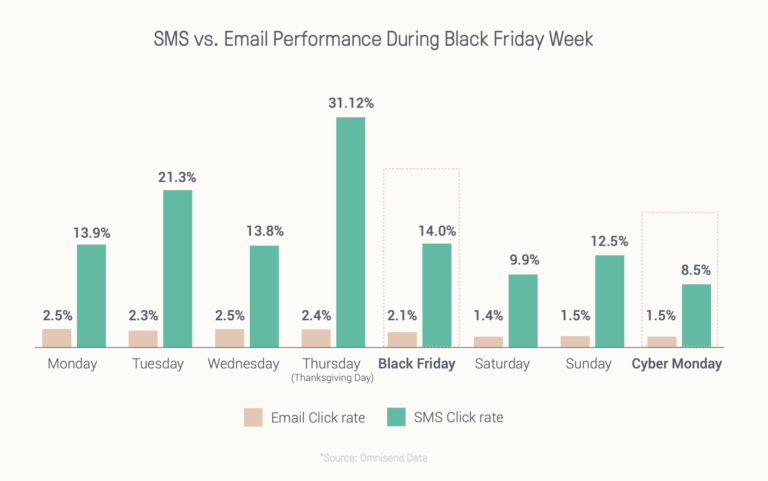The Complete Guide to SMS Marketing for Ecommerce
- Why SMS works for Ecommerce
- How it's done right
- Best practices for SMS performance
- SMS Marketing Service Providers
- Compliance for text messaging marketing
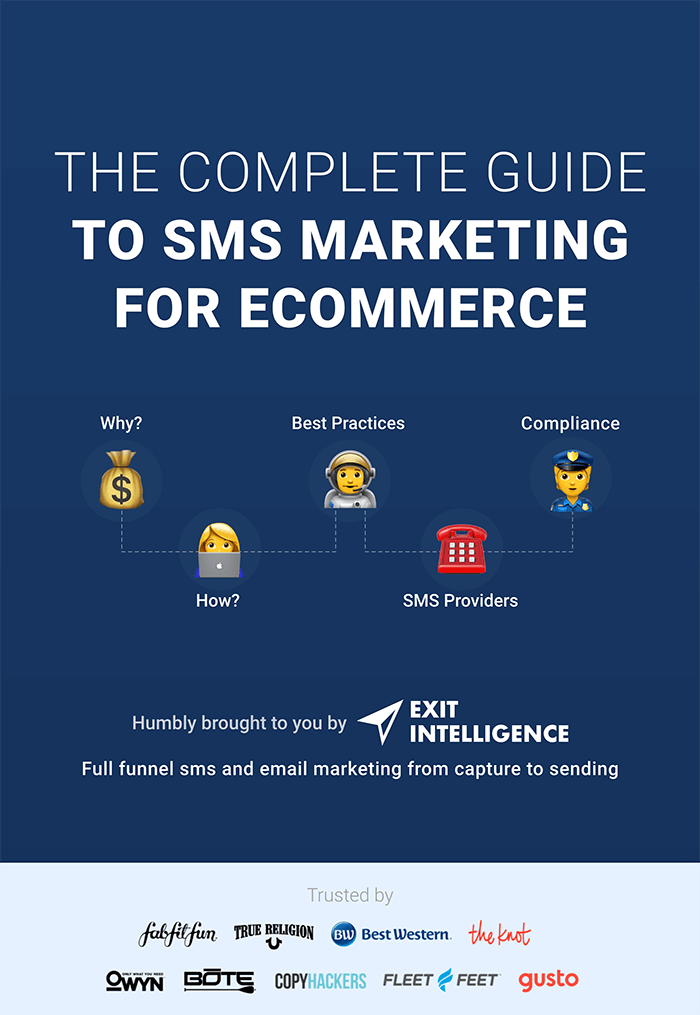

Table of Contents
Why SMS Marketing for eCommerce?
SMS marketing is not a new concept, it has been around for quite some time, but it has exploded in popularity for ecommerce companies lately – and for good reasons we’re going to take a look at right now.
SMS, or short message service, is simply another way for companies to connect with their current and potential customers. SMS, or text message marketing, allows companies to send their audience a message that appears on their mobile phone just seconds after it’s sent, which often also gives the subscribers a push notification that it’s arrived.
Text messaging marketing has gained popularity recently for a variety of reasons including: being a quick method of connecting with your audience, a high engagement rate, and a higher open rate compared to email, 98% compared to 20% respectively. And since 90% of people read a text message within the first three minutes of receiving it, it’s a highly effective way to communicate with your customers.
Now you may be thinking, “I should ditch email campaigns and go all-in for SMS marketing.” Let’s not go that far just yet. Email is an extremely valuable channel, as marketers, we should look at SMS as another channel. Leveraging both email and SMS will produce the best results.
Two Main Types of SMS Marketing Automations & Campaigns
Just like email marketing, you need to think of SMS marketing in the same way. There are typically two main ways to do SMS marketing – 1) automations and 2) campaigns. Some things you need to do based on behavior (automations) and there are things you need to do based on calendar, or holidays, or announcements of sales, etc (campaigns).
SMS Automations
Examples:
- SMS Shopping Cart Abandonment
- SMS Browse Abandonment
- SMS Replenishment
SMS Campaigns
Examples:
- Holiday Sales
- Black Friday / Cyber Monday
- New Product Announcements
First, let’s talk about SMS automations and how to do them well through text and further into the guide we’ll discuss how to run sms campaigns and how to fit them in your brand’s marketing effectively to not crowd out your SMS automations.
Types of SMS Automations for Ecommerce
There are a variety of types of SMS automation marketing for ecommerce such as welcome campaigns, shopping cart abandonment, order status updates, and post-purchase reviews.
The methods that you choose should be dependent on your brand and what your audience would react most positively to. Each of these types are similar to email marketing, but SMS does so with a maximum of 160-characters, instead of a limitless email.
Welcome Campaigns for SMS
You may ask your website visitors to subscribe to text message marketing and enter them into a welcome campaign series. Welcome series can be extremely effective as the subscriber is extremely active since they just got onto your list. Here’s an example of an SMS Welcome series:
#Pro Tip: Take the knowledge you’ve learned from your email marketing welcome campaign, and consolidate your main points to 160 characters:
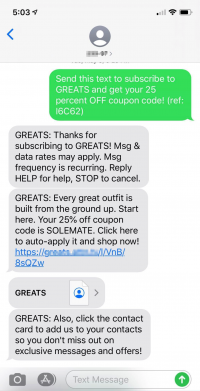

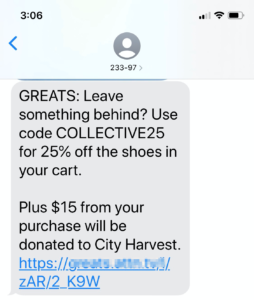

SMS Shopping Cart Abandonment
The same way you know and love shopping cart abandonment emails for your brand, you should be using SMS to remind visitors to finish checking out via SMS, too. Studies have shown that on average, 79% of visitors abandon their shopping cart. Shopping Cart Abandonment text messages are the most profitable text message automation you can setup for ecommerce.You NEED to be doing shopping cart abandonment (SCA) through text, it’s really the table stakes for an effective SMS marketing strategy.
Here’s an example of a SMS Shopping Cart Abandonment Text:
Order Status Updates
Another great way to utilize SMS to provide your customers with a more personalized and instantly form of communication withorder status updates. Not only does this create happy customers, but it also creates a long SMS marketing subscriber list and cuts down on unnecessary and resource-consuming customer support interactions. A order status text may look something like the image to the right.
It’s helpful to point out that a good order sequence not only provides quality customer support but it also produces add-on revenue as well as being a major tool for opt-in SMS list growth. At Checkout you should require the visitor to enter their phone number at checkout for them to opt-in for “order updates and other marketing related text messages”. More on the opt-in methods later.
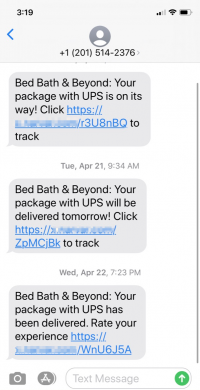



Post-Purchase Reviews
Product and service reviews are extremely important for most companies to build trust with prospective buyers. You might already follow up with customers via email but you should consider reaching out with SMS post purchase as well. One method, assuming your SMS Marketing Provider can support it, is to first reach out and ask the visitor how they are enjoying their purchase and unless they respond negatively, reply right back with asking them to share their feedback in a review either on your site or wherever is most helpful for your brand like Google or a dedicated reviews site. The SMS text message flow would be a post purchase automation first asking how everything went and then asking them to leave a review.
Best Content to Send in SMS Campaigns
The same way you create campaigns for email marketing is how you should think of campaigns for SMS marketing, you just have a much shorter content form. Keep in mind, you don’t want to overload your visitors with email and text messages, but the channels are so different that you can utilize both methods of marketing. For example, if you’re running a promotion calendar and you’re planning to structure your sending schedule around holidays, you may want to space messages out so that one day you email customers and the next day you text them, rather than sending both an email and text one day.
Ideas for SMS Marketing Campaigns:
- New product launches
- Back-in-stock alerts
- Sales and promotion notifications
- Events
- New store openings
- Holiday-based campaigns, Thanksgiving, Black Friday, Cyber Monday, Christmas, New Years, Valentine’s Day, St. Patrick’s Day, Mother’s & Father’s Day, Easter, 4th of July, Labor Day)
If you have a brand that focuses more heavily on certain holidays, craft email and SMS marketing campaigns with the holiday as the focal point.
SMS Marketing Providers
With SMS marketing growing in popularity, there are a number of companies that provide services to handle SMS marketing on your company’s behalf. Some companies handle SMS marketing only, while others provide both SMS and email services. Here is a list, not exhaustive, of companies to consider when implementing SMS marketing into your brand:
Email + SMS
SMS Only
Methods For Growing Your SMS Subscribers
- Ecommerce Checkout
a. Ask your visitors to subscribe to marketing text messages at checkout. If you require a phone number at the beginning of checkout, by asking for consent to send marketing messages, you are likely to gather many phone numbers
b. This option limits the number of people you ask for their phone number to only people who make it to the checkout, thus building an SMS list of high-intention customers.


2. Popups and sticky bars
a. Creates the opportunity to ask for a phone number through a form, anywhere on your site!
b. This can be done via a pop-up, a banner on the top or bottom of your page, or anywhere else. Be sure to A/B Test and see what converts best.
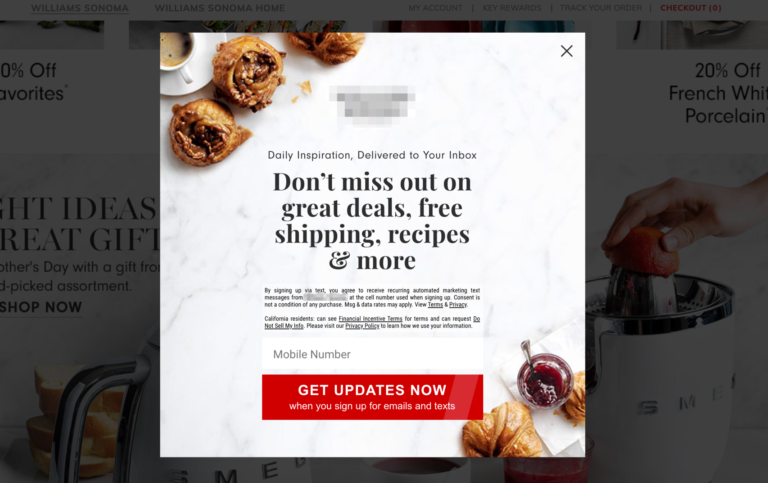

SMS Capture Methods
Phone number input field
A simple form that asks the consumer to type in their phone number
🖥️ Best for desktops and tablets
"Tap-to-Text"
A button to activate a pre-filled text message and phone number, for the consumer to sign up by texting your brand the pre-filled message
📱 Best for mobile devices
How does ‘Tap To Text’ work?
‘Tap To Text’ leverages a button that initiates a pre-filled text message when clicked on from a mobile device. This button uses a link that explicitly defines who the text should be sent to (your SMS service provider) and the body that should be pre-filled for the text when sent. Here’s an example in steps:
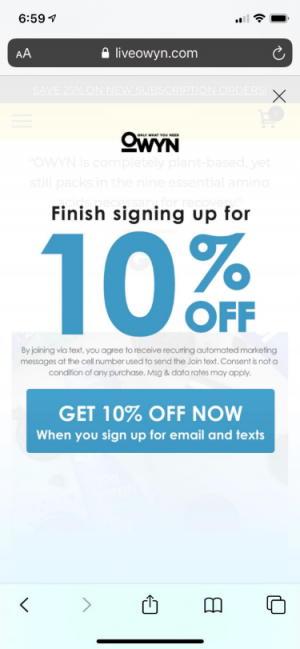

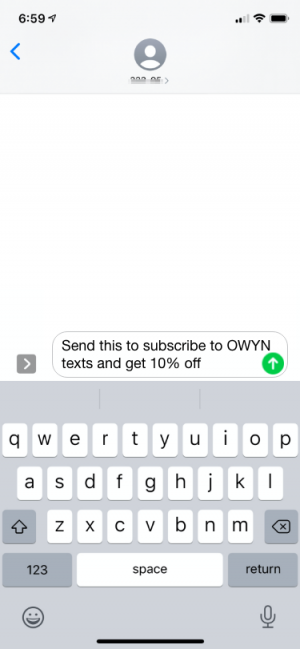

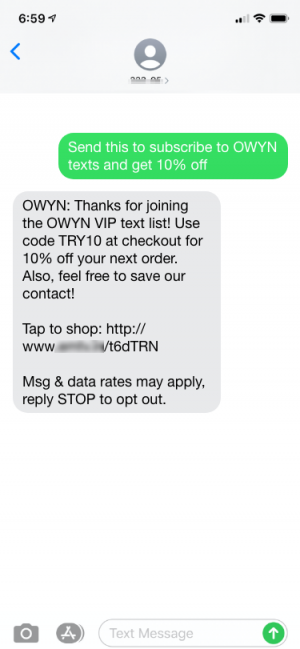

When you click the button, it will pull up the phone’s default texting app with a text to be sent to that particular number along with the text body pre-filled to what was specified in the link. Most SMS marketing providers use this method because they can automatically tell who sent the message (the “from” number), which means they don’t have to enter in the subscriber’s phone number because it’s attached to the message being sent.
At this point, most SMS marketing providers use some form of keyword matching to know what needs to be done with that particular subscriber. When a keyword is found it can then associate that number with an automation or put that sms subscriber into a particular list.
Depending on the complexity of the SMS provider, it’s possible to send the subscriber a link, that when clicked can bring the visitor back to the client’s site and associate that visitor’s session behavior with that particular phone number. This can be helpful when performing automation such as shopping cart abandonment, which relies on understanding whether or not the visitor completed a purchase during the session.
Tracking purchases can be done through the session tracking or simply based on coupon usage or even time based attribution. All of this depends on the capabilities of your shopping cart platform and your SMS Marketing provider.
Consent Considerations When Growing SMS Subscribers
Consent and knowing the laws is incredibly important when you decide to implement a SMS marketing campaign. When you are gathering website visitor’s phone numbers or encouraging them to ‘Tap To Text’, make sure they understand what it is they are opting into. Be clear that they are opting in to receive marketing text messages, that they may be charged for text messages, and that they can stop receiving them at any time. Most texting providers, by default, recognize ‘STOP’ and will unsubscribe that person from marketing-related text messages.
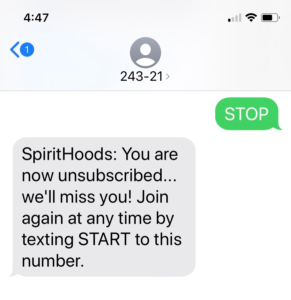

Email Opt-in and SMS Opt-in - How To Do Both Well
Every brand’s audience is different and to be successful, it is crucial to speak to your audience in a manner that causes them to react positively. Be cautious of marketers who claim there is a ‘one size fits all’ method of connecting with your audience. Email and SMS strategies that we’ve seen work well vary widely between companies because they need to be tailored to the specific goals of each business.
If you know that email capture is incredibly important for your business, don’t completely ditch email marketing and email capture on the site to try SMS. Instead, stick with where the results are and optimize that, while also testing out adding other methods. We love SMS marketing and believe it can be incredibly effective, but don’t turn off a consistent and reliable revenue channel before you prove it out.
Instead, find out how to integrate SMS marketing into your current marketing strategy. One way to start with this, if email is important for your brand, is to begin by asking the visitor for their email address first then asking them to subscribe via text after providing email. You can also test asking for email address and phone number at the same time in a pop-up.


It is also important to recognize what type of device your visitor is using. If they are on desktop, you do not have the ability to ask for their number via ‘Tap To Text’. However, you may want to take this route if they are on a mobile device.
However, you can still capture phone numbers from desktop traffic by simply asking them to type in their phone number.
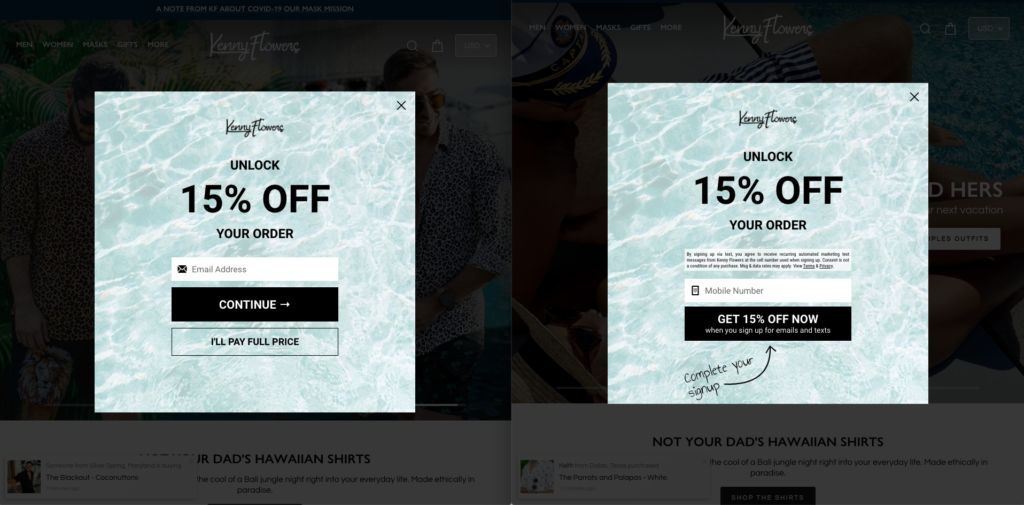

Another strategy for capturing SMS without decreasing email capture is to offer the visitor some type of incentive. One way to do add on SMS after email is to offer an incentive for when they opt-in with their email address and then immediately offer an additional bonus incentive if they subscribe via SMS.
However, if you’re asking for both email address and phone number, remember to keep an eye on your bounce rate. The more you ask a visitor to do, the more friction and frustration you may create which often translates to a higher bounce rate. You don’t want to ask for too much information which causes them to leave your site. This might not show up right away in “bounce rate” – you will want to keep an eye on Conversion Rates. We recommend using an outside tool to measure and compare performance like Google Analytics vs simply going by metrics from ESPs or SMS providers.
To combat any negative side effects of adding in SMS capture, you may consider layering in your timing for when you request visitors to opt-in with specific information. For example, start with capturing email via a pop-up at the beginning of the session and then later ask for a phone number. However, be careful with this strategy because you need to make sure you progressively profile the visitor so that you don’t make two records in different (or the same) systems for the same visitor.
How Often Should I Message My Subscribers?
As a general rule of thumb, you should not text message your subscribers more than 2-4 times per month.
We recommend setting a cap at how many messages you will send subscribers in one month so that if you have automations set up that will send more than 2-4 messages per month, it will automatically hold back the messages or skip some in the flow.
Can I text my subscribers more than 4 times per month?
There are, of course, exceptions to this 2-4 messages rule depending on the type of your business. If you have new product releases, updates on inventory, or other things your subscribers will want to hear about and will welcome the messages, then it is fine to send more. You are able to send messages as often as you’d like, just be aware that the likelihood for visitors to unsubscribe increases with each message.
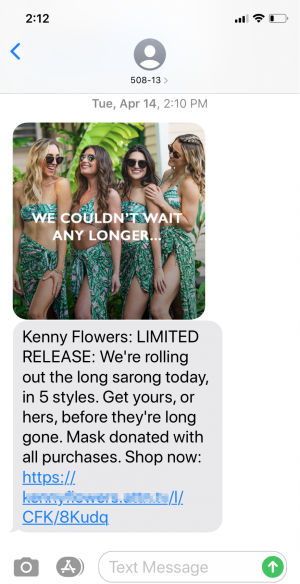

Use of Images in SMS = MMS
Using images in your SMS messages means you are sending an MMS message (Multimedia Messaging Service). You don’t have to send an image every time but it always helps get more people to actually click the link than a simple text message. If your texting provider supports it, adding in images, gifs and videos can help your texts stand out from other companies who are also utilizing SMS. Imagery also makes the messages feel more personal, fun, and engaging for consumers.
The type of imagery you use is completely dependent on your brand whether that means using lifestyle images, product images, or images with captions. Here are a few examples of each of these done well:






Gifs are also great to use in SMS messages to show off and explain products. They also provide an extra level of fun, the same way you would use gifs when messaging friends!
Additionally, videos can also be a great way to send very personal content to your subscribers. Imagine receiving just a text message versus a text message with a video of a friendly face from the company helping explain something that you already showed interest in via your onsite behavior but have yet to buy. This is next level SMS Ecommerce Marketing territory.
Long Codes vs Short Codes
A long code number is a standard phone number used to send and receive voice calls and SMS messages. Phone numbers are typically called “long codes” (10-digit numbers in many countries) when comparing them with SMS short codes (5-6 digit numbers). (Twilio)
Long Codes
Short Codes
What is it?
A unique 10-digit phone numbers that tied to a country and area code
Ex: +1 (800) 528-7566
A 5 to 6 digit number that can be user nationwide
Ex: 290-71
Sending limitations
200 SMS per day limit
+ 1 SMS per second
No daily limits
Costs
💲
💲💲💲
Things to consider
- Looks more like a normal person
- Sending limitations can be avoided by using multiple numbers
- Is clearly an automated marketing text
- Requires an approval process
- Some SMS Marketing Providers share short codes to save on cost
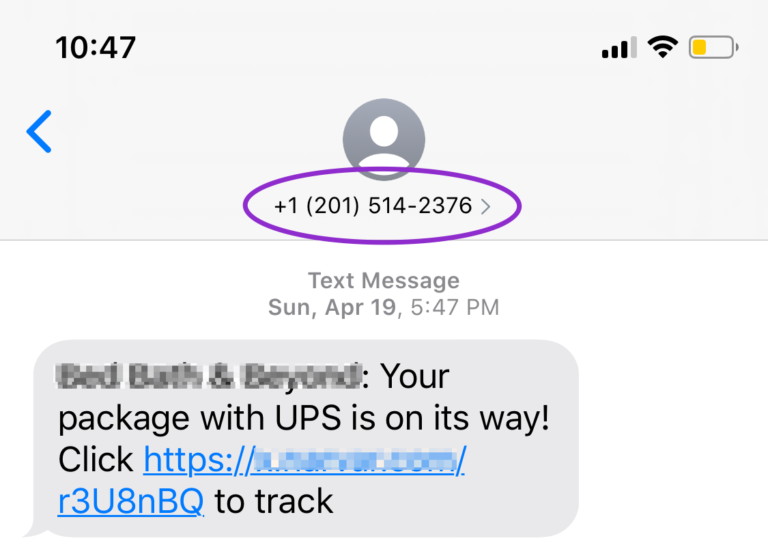

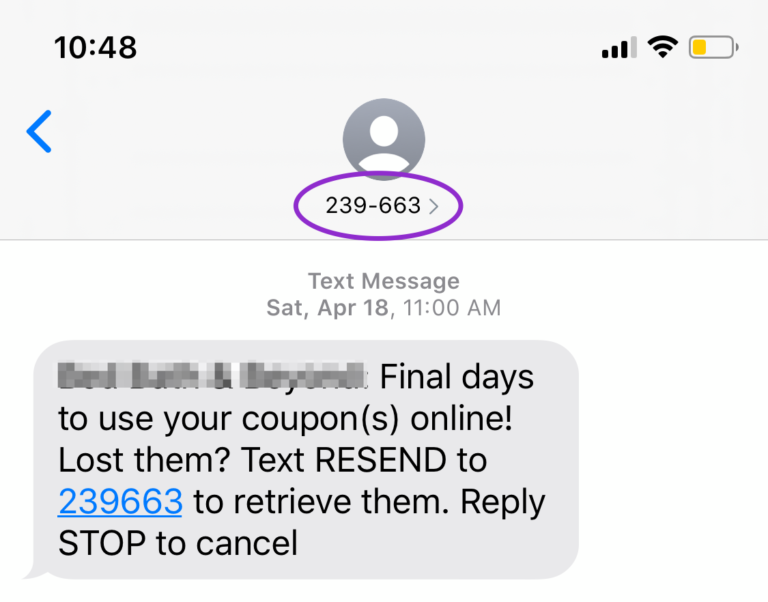

There are pros and cons to both types of codes. Short codes are more expensive for text messaging providers to use but they typically offer more capabilities. Short codes can be broken up into two categories: Shared Short Codes and Dedicated Short Codes.
Shared Short Codes
Shared short codes are numbers that multiple brands use to send texts to their subscribers. When multiple businesses use the same short code, each company is limited in the keywords they can use because only one company can use a specific keyword. Shared short codes can also cause major issues because if a visitor subscribes to your texts and another brand’s texts that use the same number, then your messages may show up in the same thread as another brand for that subscriber. Additionally, if the subscriber decides to unsubscribe from one of the brands, then it will unsubscribe them from all the brands that use that code/number. However, shared short codes exist because there are benefits such as incoming SMS messages are free, they are easy to set up, and are overall more affordable.
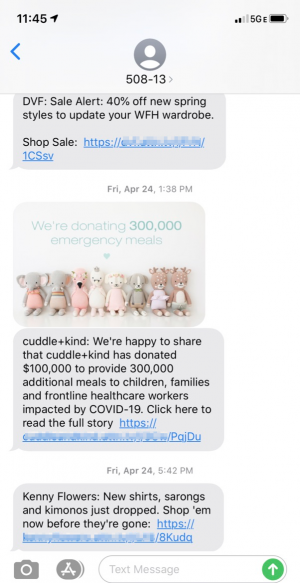

Dedicated Short Codes
Dedicated short code is a short code number that only one business can use. They can be either a randomly generated number or a specific number. For example, a pizza place may choose a dedicated short code of 74992 because it spells out “PIZZA”. Dedicated short codes allow businesses the freedom to choose any keyword they’d like because they don’t have to share with other companies. They also provide companies more control over brand image because they know exactly what subscribers are receiving from the specific number.
Long Codes
Some of the capabilities short codes have can be produced by using long codes but the limitations of using long codes need to be acknowledged. Most providers that use long codes have created ways to work around limitations. The main limitation to long codes is that you can only send 1 message per second so if your brand relies on sending blasts to a large number of subscribers at once, long codes may not be as useful for you. To get around this, brands may need to use multiple long code numbers or you can use a short code which can text up to. Additionally, since the number is longer, there is more room for error when users are entering the number into their phone.
Long codes have their uses, though. One benefit of long codes is that they look more like all of the other messages in your subscribers’s phone, therefore, look less like spam. They also have better deliverability, and most SMS providers have figured out that if a brand uses multiple long codes, they should keep a consistent number for each subscriber. For example, if a subscriber receives a text from one long code out of a pool of long codes, that subscriber should only be messages from the same long code phone number going forward.
Which Type of Code Should You Choose?
Short codes and long codes both have their advantages and disadvantages.
It’s really up to you to decide on short code vs long code and depending on your SMS Marketing choice of provider, they might make that decision for you based on their limitations or best practices. Essentially, If you need to send a mass quantity of messages, all at the exact same time, then you will need a short code. Otherwise, you simply need to understand the two types of numbers you can text from and work around any limitations in your SMS Marketing strategy.
International Text Messaging Considerations
International SMS Marketing Costs
SMS and MMS on all platforms are billed with a variable cost per message and this fluctuates per country. Take this into consideration when you’re building out your strategy.
Opting International SMS Subscribers for Marketing
If you’re offering SMS to subscribers in more than one country and you are utilizing a phone number input field on an SMS Pop up or even at checkout, be sure the form validates and allows for country specific phone number input.


FAQ
Can I text subscribers from different numbers?
Yes, you can text from different phone numbers, but be sure to include your business name at the beginning of the text.
Most text providers do this by default, so you should be okay, but an SMS subscriber is opting in to receive marketing messages from your brand, not just one phone number. However, if your subscriber requests to stop receiving messages, you cannot just switch to a different number and continue texting them.
Best practice is to always text from the same phone number if you can. You should avoid switching numbers if possible, but it is okay if you do switch. Some providers will allow you to port phone numbers to a different provider, but that is not a guarantee as your SMS provider in many causes will own the number you are sending messages from.
What do unsubscribe rates look like for SMS?
On average SMS unsubscribe rates are between 3-5%
When is the best time to send messages?
Wednesdays and Sundays are typically the best day to send marketing text messages. Since it is important to send text messages between the hours of 8am and 9pm, and many people do not check their phones during work hours, you should aim to send messages between 5pm-8pm.
Legal Nitty Gritty
There are a few laws around SMS marketing that every company should be aware of before implementing a SMS marketing campaign. While we will outline a few of these rules and regulations here, it is crucial to understand that you must research and understand the laws on your own, as this is not an exhaustive or thorough list of all the rules and regulations.
A few things to keep in mind when implementing SMS, as outlined by Citygro:
- Recipients must be able to opt-out by replying directly to the text message
- Text messages must include the identity of the entity sending the text and opt-out instructions at least monthly
- Text messages for marketing purposes can only be sent between the hours of 8 am and 9 pm (local time of the receiver)
- Text messaging programs are required to automatically opt out recipients who reply with any of the following universal keywords; STOP, END, CANCEL, UNSUBSCRIBE, and QUIT
- A confirmation text is required to be sent immediately after a consumer has opted in for marketing messages (or as soon as reasonably possible)
- A privacy policy needs to be in place that provides up-to-date and accurate information about the program details and functionality
- You need to provide a disclaimer when asking for customer’s phone number to make it apparent that you will be sending marketing messages
Here are a few messages to provide your audience when they sign up for text message marketing:
- By joining via text, you agree to receive recurring automated marketing messages from {COMPANY NAME} at the cell number used to send the Join text. Consent is not a condition of any purchase. Msg & data rates may apply. View Terms & Privacy.
- By entering your phone number, you agree to receive marketing messages at the number provided. Consent it not a condition of purchase. Message and data rates may apply. Message frequency varies. Reply HELP for help or STOP to cancel. View our Privacy Policy and Terms of Service.
- Msg & data rates may apply, reply STOP to opt out.
Key Takeaways
SMS Marketing has exploded in popularity lately and for good reason, ecommerce brands are seeing impressive open and conversion rates.
1. SMS Automations vs Campaigns
SMS automations are based on your audiences’ behavior such as shopping cart abandonment and replenishment. SMS campaigns are calendar-based such as holiday promotions and new product announcements.
2. SMS Subscriber Growth
There are a variety of ways to grow your SMS subscriber list:
- At ecommerce checkout – ask visitors to subscribe to marketing text messages when they are at checkout purchasing a product.
- Popups or sticky bars – ask visitors to subscribe to SMS marketing through a form, anywhere on your website. This can be done through a phone number input field, a simple form that asks the consumer to type in their phone number, or “tap-to-text” which is a button on mobile sites that activates a pre-filled text message.
3. SMS + Email Capture
Brands should be aware that it is possible to both email capture and SMS capture well, without sacrificing one or the other. One method of capturing both email and SMS is asking visitors for their email address first, and then immediately in the next step asking for their phone number (could be from “tap-to-text”. You may also want to offer one incentive for entering email and then a ‘bonus’ incentive for entering a phone number. Another option is to ask for their email at the beginning of the session and then later on ask for a phone number.
4. Long codes vs Short codes
Long codes and short codes are used in SMS marketing.
- long codes (10-digit numbers in many countries) ex: +1 (800) 528-7566
- short codes (5-6 digit numbers) ex: 290-71
They both have advantages and disadvantages, but essentially, If you need to send a mass quantity of messages, all at the exact same time, then you will need a short code. Otherwise, you simply need to understand the two types of numbers you can text from and work around any limitations in your SMS Marketing strategy.
5. SMS Marketing laws
There are many laws regarding SMS marketing and it is essential for you to understand them before launching a text message marketing campaign.
Want this all done for you?
We’re Exit Intelligence and we’re a fully managed SMS and Email Capture Solution.
We handle everything:
- Strategy of Customer Acquisition
- All custom designs and campaigns setup for you
- And we A/B test everything for you
- You focus on everything else and we focus on ecommerce growth through acquisition for you!
Check out the work we’ve done for clients or schedule a call today!



